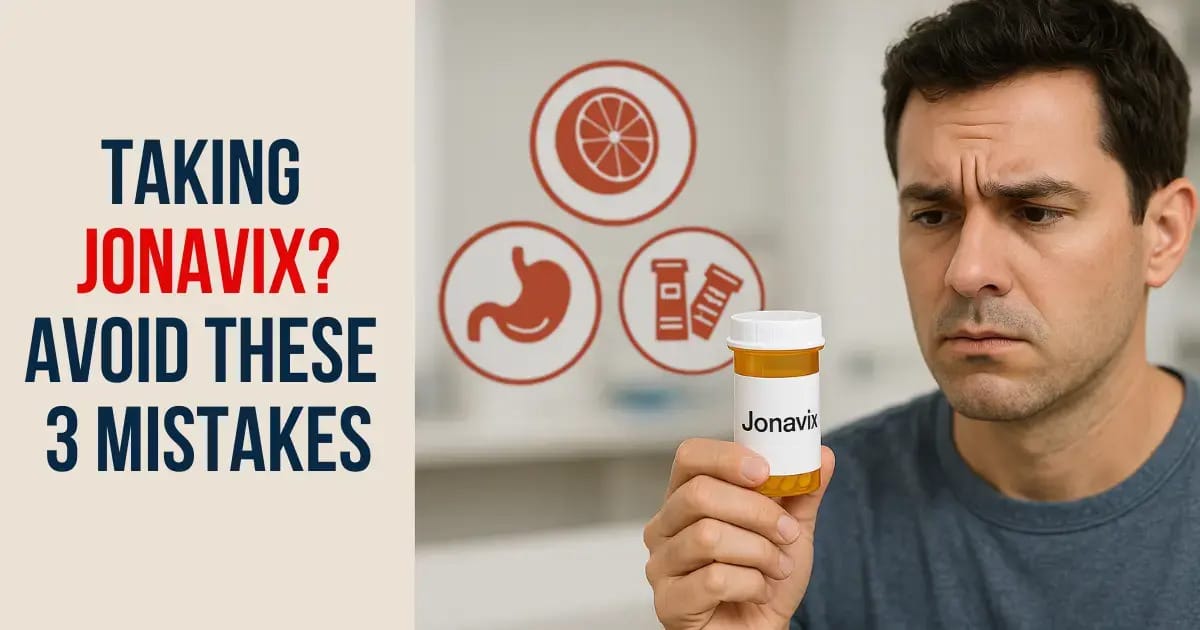Taking Jonavix? Avoid These 3 Common Mistakes
Simple changes that can make this new pain medication work better and prevent dangerous interactions

Dr. Natalie Reyes, PharmD is a clinical pharmacist with over 18 years of experience specializing in medication safety and patient counseling. Known for her clear, compassionate communication, she helps patients understand how to use new medications effectively, especially when navigating complex treatment plans.
When your doctor prescribes a new medication, you usually get the basics: how many pills, how often, and some side effects. But with new drugs like Jonavix (suzetrigine), crucial details often get missed.
As a pharmacist focused on medication safety, I see how small oversights with Jonavix can lead to reduced effectiveness, unexpected side effects, and dangerous drug interactions.
What makes Jonavix different? Unlike opioids, it targets specific pain channels in your nerves, not your brain. That’s why it doesn’t cause addiction or brain fog—but also why it interacts differently with your body915.
After counseling hundreds of patients, here are the three most common mistakes people make with Jonavix—and how to avoid them.
Mistake #1: Taking It on an Empty Stomach
Jonavix is highly lipophilic (fat-loving). Taking it without food can reduce absorption by up to 40%—meaning you only get about 60% of your dose15. For pain relief, that’s a big drop.
Solution:
Take Jonavix with a meal or substantial snack
Include healthy fats (avocado, nuts, olive oil)
Adjust timing to coincide with meals (check with your provider first)
Don’t take it immediately upon waking unless you’re eating right away
Mistake #2: Mixing with Grapefruit or Certain Medications
Jonavix is processed by liver enzyme CYP3A4. Grapefruit and some medications interfere, raising Jonavix levels by up to 100%—risking serious side effects15.
Watch out for:
Grapefruit or grapefruit juice (avoid completely)
Certain antibiotics (clarithromycin, erythromycin)
Antifungals (ketoconazole, itraconazole)
Some heart and HIV meds
Hormonal contraceptives (effectiveness reduced)
Solution:
Mistake #3: Misunderstanding What It Treats
Jonavix is for acute pain (surgery, injury, dental, etc.), not chronic pain (arthritis, fibromyalgia, neuropathy)5915. Using it for the wrong type leads to disappointment.
Solution:
Be clear with your doctor about your pain type
For chronic pain, discuss other strategies (physical therapy, anti-inflammatories, etc.)
Special Considerations for Adults Over 40
Multiple medications: Higher risk of interactions—schedule yearly medication reviews, use reminders, keep a list handy
Age-related metabolism changes: May need lower doses; side effects can appear at standard doses
Common side effects: Headache, nausea, dizziness, vomiting—often manageable by adjusting timing, taking with food, and hydration413
Practical Tips
Insurance: Check coverage before filling; ask about prior authorization and manufacturer coupons
Pharmacy availability: Call ahead, allow 24–48 hours for ordering
Travel: Keep in original container, bring extra, check international rules
Tapering: No withdrawal risk, but gradual reduction often smoothest—consult your provider
Long-term pain: Develop a comprehensive plan with your healthcare team
When to Call Your Doctor
Severe or persistent side effects (headache, dizziness, nausea, rash, allergic reactions)
Sudden worsening pain or new symptoms
The Bottom Line:
Jonavix is a major advance for acute pain, but only if you avoid these three mistakes:
Take with food
Avoid grapefruit and check interactions
Use for the right type of pain
Share this article if it helped! Subscribe for more evidence-based health insights.